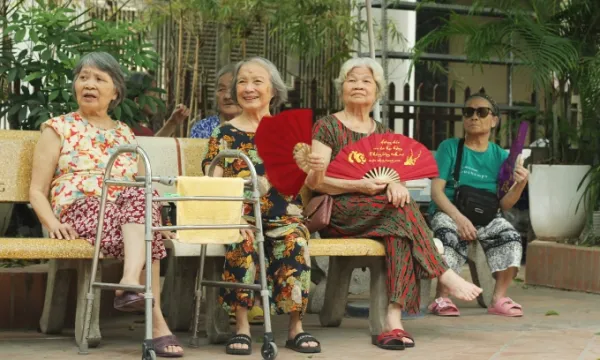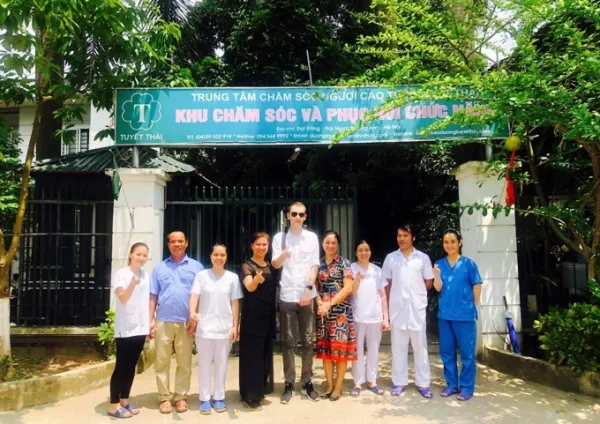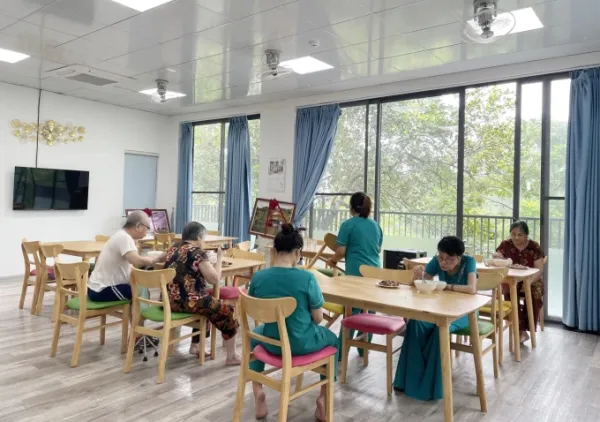
While Japan took 24 years and Germany nearly half a century for its elderly population to grow from 7% to 14%, Vietnam is reaching that point in just around 13 years.
In 2024 the country had 14.2 million people aged 60 and above, accounting for 14% of its population, and is expected to become an “aged” society by 2036.
Falling birth rates are accelerating the trend. The country’s fertility rate is only 1.67 children per woman, but drops to 1.39 in Ho Chi Minh City, which is close to Germany’s 1.35 and Japan’s 1.2.
“Vietnam faces the prospect of growing old before getting rich, creating unprecedented pressure on its social welfare, healthcare, and workforce systems,” Gnadt, who did months of research in Vietnam, says.
He says Vietnamese families are changing rapidly due to modernization. Family structures are shrinking, and generations are becoming more distant, which has weakened the traditional practice of children caring for parents, he says.
|
Elderly residents at a nursing home in Hanoi, on Sept. 23, 2025. Photo by Read/ Phan Duong |
Many find themselves trapped between caring for elderly parents and raising their own children, leading them to seek alternatives such as hiring caregivers and sending parents to retirement homes, he says.
A phenomenon known as “vertical urbanization”, in which elderly people live in cramped high-rise apartments, separated from their communities, is leaving many feeling lonely and abandoned, he observes. “The care crisis is becoming increasingly visible.”
During a technology transfer and workforce training project for retirement homes in Hanoi, Takanori Hisaoka, executive director of the Kiramekikai Social Welfare Organization (Japan), too referred to the two major challenges facing Vietnam: aging before becoming wealthy and weakening of the intergenerational bond of care.
“Vietnam is walking the same path Japan once did, but at a faster pace and with fewer resources,” Hisaoka, who has more than 20 years of experience in elderly care, said. As a result, Vietnam’s elderly care network remains inadequate.
Coordination between healthcare and long-term care services is fragmented, and specialized services such as dementia care are almost nonexistent.
The situation is further complicated by disparities in access between urban and rural areas and rich and poor, while the caregiving workforce remains both insufficient and undertrained, he said.
Yet both experts see a bright side in Vietnam’s cultural values. “Vietnam still holds what many developed countries have lost: community cohesion, neighborhood support and natural intergenerational care,” Gnadt notes. “If utilized correctly, these can form the foundation of an effective, low-cost and deeply humane care system.”
 |
|
Christopher Gnadt (in glasses) during a visit to a nursing home in Hanoi in 2018. Photo courtesy of Gnadt |
Inspired by this community spirit, Germany has developed the “aging in place” model, which allows elderly people to stay in their homes as long as possible. Around 80% of German seniors are cared for at home by professional caregivers.
According to Gnadt, Vietnam should act on two fronts: maintaining family-based care while professionalizing home support, community nursing, and insurance systems.
Cities also need to improve infrastructure to be more aged-friendly, he says. Learning from Germany’s current reliance on foreign caregivers, he says Vietnam should invest early in caregiver training.
“If Vietnam invests soon in training and better working conditions for caregivers, it will adapt successfully to population aging.”
Hisaoka also believed that Vietnam’s tradition of filial piety and family affection is the key and suggested three models from Japan that could fit Vietnam.
 |
|
A nursing home in Xuan Mai, Hanoi, receives advice from expert Takanori Hisaoka on elderly care technology transfer and caregiver training. In the photo, elderly residents have lunch in August 2024. Photo by Read/ Phan Duong |
The first model is small-scale, multifunctional community care centers that combine day services, short stays and home care within neighborhoods. This approach helps seniors maintain familiar routines and reduces operating costs while ensuring quality.
Instead of building large facilities, this model minimizes expenses yet preserves the quality of life and allows family members to continue working.
In Japan, it is widespread in residential areas, and in Vietnam, where neighborhood bonds remain strong, it could be easily adapted, Hisaoka said. “Families remain the main caregivers; they simply activate daytime or short-stay services when needed.”
The second model is the “group home,” a communal living arrangement for six to 10 residents designed like a family setting, which works especially well for those with dementia.
The third model is “assisted independent living,” which targets more affluent seniors who live in private apartments equipped with medical, nutritional and 24/7 care monitoring systems.
Gnadt said Vietnam must follow a dual strategy by diversifying care facilities in the short term and strengthening family support systems and encouraging couples to have two children in the long term. “Elderly care is a test of social governance.
“If Vietnam invests early in infrastructure, training and family support, aging can become an opportunity to improve the quality of life and foster economic growth rather than become a burden.”